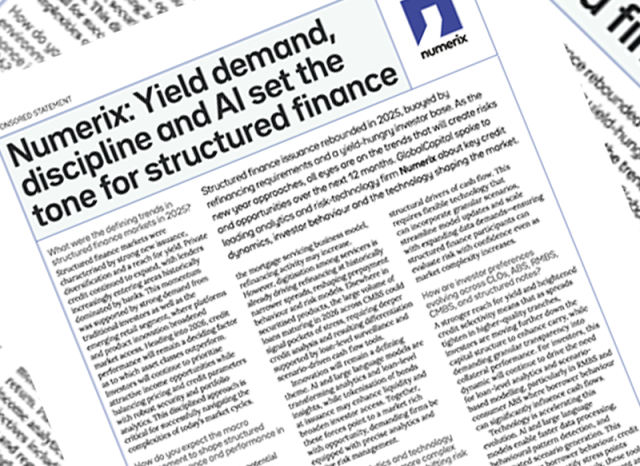The Quant Revolution Comes for Fixed Income
The fixed income market is undergoing a full-scale transformation as quantitative strategies, once the domain of equities and derivatives, begin to reshape how bonds and credit products are priced, traded, and risk-managed. In this article, which originally appeared on TabbFORUM, Numerix explores the growing impact of advanced analytics, cloud technology, and cross-asset modeling on fixed income markets, highlighting the opportunities and challenges for investors, issuers, and risk managers alike.
Systematic fixed income has moved from the fringe to the frontier of institutional investing, benefitting from the convergence of improved market infrastructure, powerful technology, and advanced modeling. As the ecosystem of vendors, platforms, and service providers matures, adoption is poised to continue its upward trajectory. This article highlights the three primary forces that are accelerating the adoption of systematic fixed income strategies, which are lowering barriers to entry and enabling quantitative models to thrive.
The Rise of Systematic Strategies in Fixed Income
Systematic investing, the use of rules-based quantitative strategies, has long been a staple in equity and futures markets. Now, this quantitative revolution is rapidly gaining traction in the traditionally discretionary world of fixed income. A convergence of market evolution, data availability, and technological power is enabling investors to systematically trade bonds and credit instruments at scale, unlocking new opportunities for alpha and diversification.
For years, fixed income lagged equities in quantitative adoption. Trading was dominated by high-touch, over-the-counter (OTC) negotiations, making it difficult to implement automated strategies. However, this landscape is shifting. Renewed focus on credit strategies, driven by higher interest rates and wider spreads, has prompted institutional investors to look beyond traditional methods. As a result, systematic fixed income is moving from a niche strategy to a mainstream component of institutional portfolios.
What’s fueling the shift?
Three primary forces are accelerating the adoption of systematic fixed income strategies, lowering barriers to entry and enabling quantitative models to thrive.
1. Market Evolution and Electronic Trading
One of the most significant enablers has been the “electronification” of bond markets. Historically, fragmented liquidity and opaque pricing in OTC markets were major obstacles. The introduction of platforms like the Trade Reporting and Compliance Engine (TRACE) in 2002 brought post-trade transparency to corporate bond trades, laying the groundwork for change.
Since then, electronic trading platforms have surged in popularity. By 2024, nearly half of U.S. investment-grade corporate bond trading was electronic. New protocols like all-to-all trading networks and portfolio trading—executing a basket of bonds in a single transaction—have improved liquidity and execution efficiency. These developments make it possible for quantitative signals to be executed promptly and at a lower cost, which is fundamental for any systematic strategy’s success.
2. Data Abundance and Cloud Computing
The second major driver is the explosion in data availability and the computational power to process it. Regulatory initiatives and data vendors now provide access to rich historical and real-time data on everything from transaction prices to issuer fundamentals. This data is the raw material that quantitative models need to identify patterns and test trading signals.
Handling this vast amount of information was once a significant hurdle. A single bond portfolio can contain thousands of securities, each with unique characteristics. The advent of cloud computing and modern data science toolkits, especially open-source languages like Python, has been a game-changer. Firms can now perform real-time pricing and risk calculations on massive portfolios, backtest strategies on decades of history, and deploy complex models with an ease that was previously unimaginable.
3. Advances in Quantitative Modeling
As data and trading access improved, so too have the quantitative techniques tailored for fixed income. Researchers have successfully adapted classic equity factors like value, momentum, and carry for credit markets. For example, a “value” factor in credit might identify bonds whose spreads are wide relative to their fundamental default risk, presenting a potential buying opportunity.
Furthermore, machine learning (ML) and AI are enabling more sophisticated analysis. ML models can detect complex patterns and early warning signals by analyzing a multitude of features, including alternative data like news sentiment. While challenges like low signal-to-noise ratios and rare default events persist, AI is becoming an increasingly vital tool for augmenting traditional factor models.
Navigating the Implementation Challenges
Despite the strong momentum, implementing systematic fixed income strategies is not without its barriers. Three key challenges stand out:
- Data Quality: Bond data can still be messy and incomplete. Many bonds trade infrequently, leading to stale prices and gaps in historical data. Successful firms invest heavily in data engineering to clean, validate, and enrich data from multiple sources, often using sophisticated interpolation and proxy techniques.
- Model Risk: The relative newness of systematic credit means there are fewer long-term track records. Models that perform well in backtests may not have been proven through various market cycles. This requires robust model validation, stress-testing, and risk management to prevent overfitting and ensure models are resilient during regime shifts.
- Execution and Liquidity: Fixed income liquidity remains fragmented across multiple dealers and platforms. This can lead to execution latency, where a signal’s edge decays before a trade can be completed. To overcome this, managers use smart order routers, algorithmic execution, and creative solutions like cross-instrument hedging with liquid proxies like ETFs.
Systematic Fixed Income and the Road Ahead
Systematic fixed income has moved from the fringe to the frontier of institutional investing. The convergence of improved market infrastructure, powerful technology, and advanced modeling has created fertile ground for quantitative strategies to deliver value. As the ecosystem of vendors, platforms, and service providers matures, adoption is poised to continue its upward trajectory.
Looking ahead, we can expect systematic techniques to expand into less liquid sectors like emerging market debt and municipal bonds as data becomes more accessible. For institutional investors, the key is to understand the structural changes that make these strategies viable today. By leveraging modern tools and partnering with the right counterparties, firms can successfully navigate the implementation hurdles and unlock the diversifying returns that systematic fixed income has to offer.
Dive Deeper into Systematic Fixed Income
If you want to explore this topic further, download our new white paper, Growing adoption of systematic fixed income strategies, which uncovers detailed insights on how systematic strategies are transforming fixed income markets, the technology enabling these shifts, and practical considerations for institutional investors.


